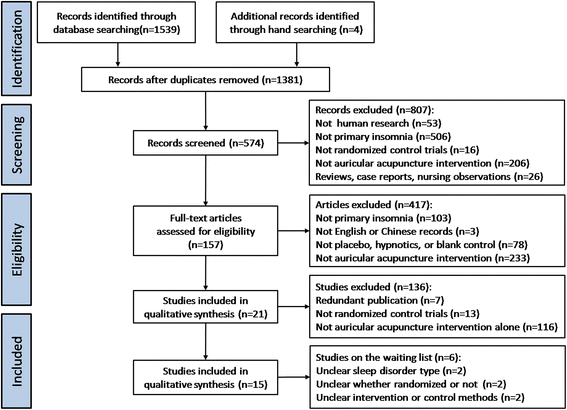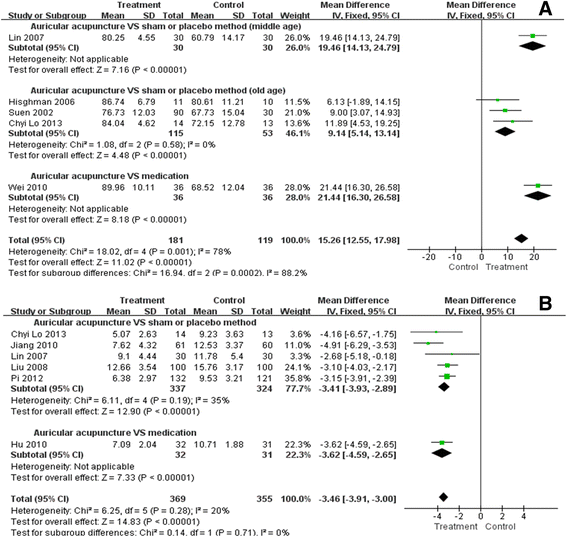Auricular acupuncture with seed or pellet attachments for primary insomnia: a systematic review and meta-analysis
- PMID: 25886561
- PMCID: PMC4425871
- DOI: 10.1186/s12906-015-0606-7
Auricular acupuncture with seed or pellet attachments for primary insomnia: a systematic review and meta-analysis
Abstract
Background: Primary insomnia is a common health issue in the modern world. We conducted a systematic review of the auricular therapy, aiming to evaluate whether there are advantages of auricular acupuncture with seed or pellet attachments for the treatment of primary insomnia.
Methods: A search of relevant literatures was performed on major medical databases, including Medline, Embase, CENTRAL, CBM, CNKI, VIP, Wanfang Data and so on. Risk of bias evaluation, meta-analysis, sensitivity analysis and evidence rating of all extracted information were conducted also.
Results: A total of 1381 records were identified, with 15 studies deemed eligible for the present review. Meta-analyses were conducted in two comparisons separately: participants received auricular acupuncture were more likely to make an improvement in clinical effective rate (RR = 1.40, 95% CI 1.07 to 1.83), sleep duration (MD = 56.46, 95% CI 45.61 to 67.31), sleep efficiency(MD = 12.86, 95% CI 9.67 to 16.06), global score on PSQI (MD = -3.41, 95% CI -3.93 to -2.89), number of awakenings( MD = -3.27, 95% CI -6.30 to -0.25) and sleep onset latency(MD = -10.35, 95% CI -14.37 to -6.33) when compared to sham auricular acupuncture or placebo; while in auricular acupuncture VS medications comparison, a better effective rate (RR = 1.24, 95% CI 1.15 to 1.34), better sleep efficiency(MD = 21.44, 95% CI 16.30 to 26.58), lower PSQI score (MD = -3.62, 95% CI -4.59 to -2.65) and less adverse effect (RR = 0.11, 95% CI 0.04 to 0.26) can be seen also in auricular acupuncture group. Although these results suggested benefits of auricular acupuncture, the overall quality of evidence rated by the GRADE system was low.
Conclusion: Statistical analyses of the outcomes revealed a positive effect of auricular acupuncture for primary insomnia. Nonetheless, considering the poor methodological quality, insufficient sample size and possible publication bias, current evidence is not yet adequate to provide a strong support for the use of auricular acupuncture in the treatment of primary insomnia. More strictly designed clinical studies will be needed to obtain a more explicit conclusion.
Figures




References
Publication types
MeSH terms
Substances
LinkOut - more resources
Full Text Sources
Other Literature Sources
Medical

